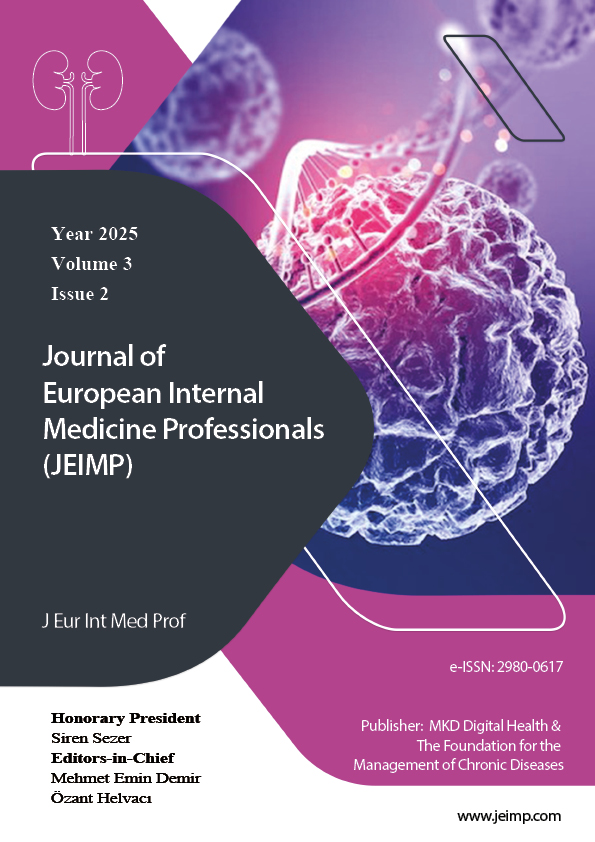What’s Missing In Diabetes Treatment? A Novel Agent Finerenone?
Diabetic Nephropathy and Finerenone
DOI:
https://doi.org/10.5281/zenodo.15065667Keywords:
Finerenone, Diabetes Mellitus, Nephropathy, Proteinuria, HyperkalemiaAbstract
Diabetic kidney disease represents a leading cause of chronic kidney disease and end-stage renal disease worldwide. The pathogenesis is primarily driven by persistent hyperglycemia, which induces oxidative stress, low-grade chronic inflammation, and activation of profibrotic signaling pathways. These mechanisms promote mesangial expansion, podocyte injury, and tubular epithelial-to-mesenchymal transition, culminating in glomerulosclerosis and tubulointerstitial fibrosis. Fibrosis is a hallmark of progressive diabetic kidney disease, characterized by excessive deposition of extracellular matrix components, leading to structural distortion and progressive decline in glomerular filtration rate.
Proteinuria, a key clinical manifestation of diabetic kidney disease, reflects dysfunction of the glomerular filtration barrier and serves as both a marker and mediator of disease progression. Filtered proteins exert direct cytotoxic effects on proximal tubular epithelial cells, inducing proinflammatory and profibrotic responses that exacerbate tubulointerstitial injury and accelerate fibrosis.
Despite standard-of-care therapy with renin-angiotensin-aldosterone system blockade, a significant proportion of patients exhibit residual proteinuria and progressive renal fibrosis, underscoring the need for additional therapeutic interventions. Mineralocorticoid receptor overactivation has emerged as a critical driver of renal inflammation and fibrosis in diabetic kidney disease. Finerenone, a novel non-steroidal, selective mineralocorticoid receptor antagonist, has demonstrated potent antifibrotic and antiproteinuric effects by attenuating the transcription of proinflammatory and profibrotic mediators, including transforming growth factor-beta and connective tissue growth factor. Finerenone reduces macrophage infiltration, extracellular matrix accumulation, and fibrosis in glomerular and tubulointerstitial compartments.
The landmark FIDELIO-DKD and FIGARO-DKD trials established the efficacy of finerenone in reducing albuminuria and slowing the progression of kidney disease in patients with type 2 diabetes and chronic kidney disease. By directly targeting key pathophysiological mechanisms of renal fibrosis and proteinuria, finerenone offers a novel and evidence-based therapeutic strategy to mitigate kidney disease progression in this high-risk population.
References
Alicic RZ, Rooney MT, Tuttle KR. Diabetic Kidney Disease: Challenges, Progress, and Possibilities. Clin J Am Soc Nephrol. 2017;12(12):2032-2045. doi:10.2215/CJN.11491116
Strain WD, Paldánius PM. Diabetes, cardiovascular disease and the microcirculation [published correction appears in Cardiovasc Diabetol. 2021 Jun 11;20(1):120. doi: 10.1186/s12933-021-01307-5.]. Cardiovasc Diabetol. 2018;17(1):57. Published 2018 Apr 18. doi:10.1186/s12933-018-0703-2
Zelniker TA, Wiviott SD, Raz I, et al. SGLT2 inhibitors for primary and secondary prevention of cardiovascular and renal outcomes in type 2 diabetes: a systematic review and meta-analysis of cardiovascular outcome trials [published correction appears in Lancet. 2019 Jan 5;393(10166):30. doi: 10.1016/S0140-6736(18)33206-9.]. Lancet. 2019;393(10166):31-39. doi:10.1016/S0140-6736(18)32590-X
Wanner C, Inzucchi SE, Lachin JM, et al. Empagliflozin and Progression of Kidney Disease in Type 2 Diabetes. N Engl J Med. 2016;375(4):323-334. doi:10.1056/NEJMoa1515920
Barrera-Chimal J, Estrela GR, Lechner SM, et al. The myeloid mineralocorticoid receptor controls inflammatory and fibrotic responses after renal injury via macrophage interleukin-4 receptor signaling. Kidney Int. 2018;93(6):1344-1355. doi:10.1016/j.kint.2017.12.016
Staessen J, Lijnen P, Fagard R, Verschueren LJ, Amery A. Rise in plasma concentration of aldosterone during long-term angiotensin II suppression. J Endocrinol. 1981;91(3):457-465. doi:10.1677/joe.0.0910457
Barrera-Chimal J, Lima-Posada I, Bakris GL, Jaisser F. Mineralocorticoid receptor antagonists in diabetic kidney disease - mechanistic and therapeutic effects. Nat Rev Nephrol. 2022;18(1):56-70. doi:10.1038/s41581-021-00490-8
Kidney Disease: Improving Global Outcomes (KDIGO) Diabetes Work Group. KDIGO 2022 Clinical Practice Guideline for Diabetes Management in Chronic Kidney Disease. Kidney Int. 2022;102(5S):S1-S127. doi:10.1016/j.kint.2022.06.008
Pitt B, Anker SD, Böhm M, et al. Rationale and design of MinerAlocorticoid Receptor antagonist Tolerability Study-Heart Failure (ARTS-HF): a randomized study of finerenone vs. eplerenone in patients who have worsening chronic heart failure with diabetes and/or chronic kidney disease. Eur J Heart Fail. 2015;17(2):224-232. doi:10.1002/ejhf.218
de Boer IH, Khunti K, Sadusky T, et al. Diabetes Management in Chronic Kidney Disease: A Consensus Report by the American Diabetes Association (ADA) and Kidney Disease: Improving Global Outcomes (KDIGO). Diabetes Care. 2022;45(12):3075-3090. doi:10.2337/dci22-0027
Currie G, Taylor AH, Fujita T, et al. Effect of mineralocorticoid receptor antagonists on proteinuria and progression of chronic kidney disease: a systematic review and meta-analysis. BMC Nephrol. 2016;17(1):127. Published 2016 Sep 8. doi:10.1186/s12882-016-0337-0
Epstein M, Williams GH, Weinberger M, et al. Selective aldosterone blockade with eplerenone reduces albuminuria in patients with type 2 diabetes. Clin J Am Soc Nephrol. 2006;1(5):940-951. doi:10.2215/CJN.00240106
Bakris GL, Agarwal R, Chan JC, et al. Effect of Finerenone on Albuminuria in Patients With Diabetic Nephropathy: A Randomized Clinical Trial. JAMA. 2015;314(9):884-894. doi:10.1001/jama.2015.10081
Bakris GL, Agarwal R, Anker SD, et al. Effect of Finerenone on Chronic Kidney Disease Outcomes in Type 2 Diabetes. N Engl J Med. 2020;383(23):2219-2229. doi:10.1056/NEJMoa2025845
Ruilope LM, Agarwal R, Anker SD, et al. Design and Baseline Characteristics of the Finerenone in Reducing Cardiovascular Mortality and Morbidity in Diabetic Kidney Disease Trial. Am J Nephrol. 2019;50(5):345-356. doi:10.1159/000503712
Ruilope LM, Pitt B, Anker SD, et al. Kidney outcomes with finerenone: an analysis from the FIGARO-DKD study. Nephrol Dial Transplant. 2023;38(2):372-383. doi:10.1093/ndt/gfac157
Pitt B, Kober L, Ponikowski P, et al. Safety and tolerability of the novel non-steroidal mineralocorticoid receptor antagonist BAY 94-8862 in patients with chronic heart failure and mild or moderate chronic kidney disease: a randomized, double-blind trial. Eur Heart J. 2013;34(31):2453-2463. doi:10.1093/eurheartj/eht187
Agarwal R, Filippatos G, Pitt B, et al. Cardiovascular and kidney outcomes with finerenone in patients with type 2 diabetes and chronic kidney disease: the FIDELITY pooled analysis [published correction appears in Eur Heart J. 2022 May 21;43(20):1989. doi: 10.1093/eurheartj/ehab886.]. Eur Heart J. 2022;43(6):474-484. doi:10.1093/eurheartj/ehab777
Solomon SD, McMurray JJV, Vaduganathan M, et al. Finerenone in Heart Failure with Mildly Reduced or Preserved Ejection Fraction. N Engl J Med. 2024;391(16):1475-1485. doi:10.1056/NEJMoa2407107
Kosiborod MN, Abildstrøm SZ, Borlaug BA, et al. Semaglutide in Patients with Heart Failure with Preserved Ejection Fraction and Obesity. N Engl J Med. 2023;389(12):1069-1084. doi:10.1056/NEJMoa2306963
Gil-Ortega M, Vega-Martín E, Martín-Ramos M, et al. Finerenone Reduces Intrinsic Arterial Stiffness in Munich Wistar Frömter Rats, a Genetic Model of Chronic Kidney Disease. Am J Nephrol. 2020;51(4):294-303. doi:10.1159/000506275
Filippatos G, Anker SD, Böhm M, et al. A randomized controlled study of finerenone vs. eplerenone in patients with worsening chronic heart failure and diabetes mellitus and/or chronic kidney disease. Eur Heart J. 2016;37(27):2105-2114. doi:10.1093/eurheartj/ehw132
Bärfacker L, Kuhl A, Hillisch A, et al. Discovery of BAY 94-8862: a nonsteroidal antagonist of the mineralocorticoid receptor for the treatment of cardiorenal diseases. ChemMedChem. 2012;7(8):1385-1403. doi:10.1002/cmdc.201200081
Fried LF, Emanuele N, Zhang JH, et al. Combined angiotensin inhibition for the treatment of diabetic nephropathy [published correction appears in N Engl J Med. 2014;158:A7255]. N Engl J Med. 2013;369(20):1892-1903. doi:10.1056/NEJMoa1303154
Rico-Mesa JS, White A, Ahmadian-Tehrani A, Anderson AS. Mineralocorticoid Receptor Antagonists: a Comprehensive Review of Finerenone. Curr Cardiol Rep. 2020;22(11):140. Published 2020 Sep 10. doi:10.1007/s11886-020-01399-7
Pitt B, Pfeffer MA, Assmann SF, et al. Spironolactone for heart failure with preserved ejection fraction. N Engl J Med. 2014;370(15):1383-1392. doi:10.1056/NEJMoa1313731
Downloads
Published
How to Cite
Issue
Section
Categories
License
Copyright (c) 2025 İlyas Öztürk, Saliha Yıldırım, Melike Polat

This work is licensed under a Creative Commons Attribution 4.0 International License.










